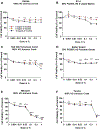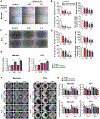Modeling Cardiovascular Risks of E-Cigarettes With Human-Induced Pluripotent Stem Cell-Derived Endothelial Cells
- PMID: 31146818
- PMCID: PMC6637948
- DOI: 10.1016/j.jacc.2019.03.476
Modeling Cardiovascular Risks of E-Cigarettes With Human-Induced Pluripotent Stem Cell-Derived Endothelial Cells
Abstract
Background: Electronic cigarettes (e-cigarettes) have experienced a tremendous increase in use. Unlike cigarette smoking, the effects of e-cigarettes and their constituents on mediating vascular health remain understudied. However, given their increasing popularity, it is imperative to evaluate the health risks of e-cigarettes, including the effects of their ingredients, especially nicotine and flavorings.
Objectives: The purpose of this study was to investigate the effects of flavored e-cigarette liquids (e-liquids) and serum isolated from e-cigarette users on endothelial health and endothelial cell-dependent macrophage activation.
Methods: Human-induced pluripotent stem cell-derived endothelial cells (iPSC-ECs) and a high-throughput screening approach were used to assess endothelial integrity following exposure to 6 different e-liquids with varying nicotine concentrations and to serum from e-cigarette users.
Results: The cytotoxicity of the e-liquids varied considerably, with the cinnamon-flavored product being most potent and leading to significantly decreased cell viability, increased reactive oxygen species (ROS) levels, caspase 3/7 activity, and low-density lipoprotein uptake, activation of oxidative stress-related pathway, and impaired tube formation and migration, confirming endothelial dysfunction. Upon exposure of ECs to e-liquid, conditioned media induced macrophage polarization into a pro-inflammatory state, eliciting the production of interleukin-1β and -6, leading to increased ROS. After exposure of human iPSC-ECs to serum of e-cigarette users, increased ROS linked to endothelial dysfunction was observed, as indicated by impaired pro-angiogenic properties. There was also an observed increase in inflammatory cytokine expression in the serum of e-cigarette users.
Conclusions: Acute exposure to flavored e-liquids or e-cigarette use exacerbates endothelial dysfunction, which often precedes cardiovascular diseases.
Keywords: e-cigarette aerosol; e-liquid flavoring; endothelial dysfunction; iPSC-ECs.
Copyright © 2019 American College of Cardiology Foundation. Published by Elsevier Inc. All rights reserved.
Figures








Comment in
-
The Adverse Vascular Effects of E-Cigarettes: Smoke Without the Fire.J Am Coll Cardiol. 2019 Jun 4;73(21):2738-2739. doi: 10.1016/j.jacc.2019.02.072. J Am Coll Cardiol. 2019. PMID: 31146819 No abstract available.
References
-
- The health consequences of smoking-50 years of progress: A report of the surgeon general. Atlanta (GA): U.S. Department of Health and Human Services, 2014.
-
- General. OotS. E-cigarette use among youth and young adults: A report of the surgeon general. Atlanta (GA): U.S. Department of Health and Human Services, 2016.
-
- Scott G Proposed new steps to protect youth by preventing access to flavored tobacco products and banning menthol in cigarettes. FDA Statement. November 2018. Availabe at: https://www.fda.gov/NewsEvents/Newsroom/PressAnnouncements/UCM625884.htm.
Publication types
MeSH terms
Substances
Grants and funding
LinkOut - more resources
Full Text Sources
Medical
Molecular Biology Databases
Research Materials

